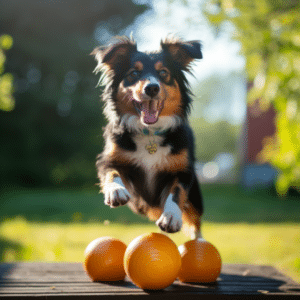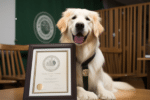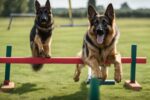Optimizing Canine Fitness for a Healthy, Happy Dog
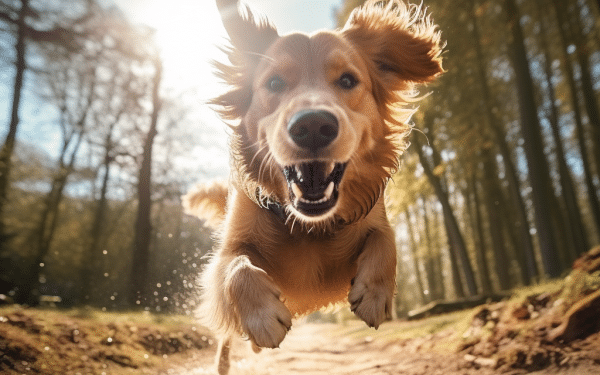
Canine fitness plays a crucial role in ensuring the well-being of your furry companion. Owning a dog has numerous benefits, including lower stress levels, reduced risk of depression, and an increased overall sense of well-being. To maintain your dog’s physical health, it is important to provide them with proper nutrition, regular exercise, and adequate hydration.
Feeding your dog a balanced diet that includes the right blend of proteins, carbohydrates, fats, vitamins, and minerals is essential for their overall health and fitness. A nutritious diet supports their energy levels, muscle development, and immune system.
Regular exercise is vital to keep your dog at a healthy weight, reduce the risk of heart disease, and prevent conditions like arthritis. Engaging in activities like hiking, swimming, jogging, or playing games such as tug-of-war or catch with your dog promotes their physical fitness while strengthening your bond.
In addition to nutrition and exercise, supporting your dog’s gut health through the use of probiotics can aid in digestion and contribute to their overall fitness. Keeping fresh, clean water available at all times is crucial for maintaining optimal hydration levels.
Investing in high-quality gear and accessories, such as sturdy leashes, comfortable harnesses, and appropriate toys, can further support your dog’s overall well-being during exercise and play.
Regular vet checkups are essential for monitoring your dog’s physical health, detecting any potential issues early on, and ensuring they receive the appropriate care.
In conclusion, canine fitness is key to keeping your dog healthy and happy. By providing them with proper nutrition, regular exercise, and ample hydration, you can promote their overall well-being and enjoy a strong bond with your furry companion.
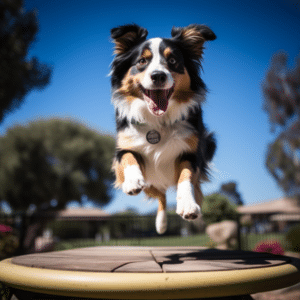
The Benefits of Canine Fitness
Regular exercise and physical activity bring numerous benefits to your dog’s health and happiness. Owning a dog comes with a variety of advantages, including lower stress levels, reduced risk of depression, and an overall increased sense of well-being. Just like humans, dogs need proper nutrition, exercise, and hydration to thrive and maintain optimal physical health.
Feeding your dog a balanced diet that provides the right blend of proteins, carbohydrates, fats, vitamins, and minerals is essential. This ensures they receive the necessary nutrients to support their overall fitness. Additionally, regular exercise helps maintain a healthy weight, preventing obesity and reducing the risk of heart disease, arthritis, and other health issues.
To support your dog’s gut health and digestion, you can introduce probiotics into their diet. Probiotics promote a healthy balance of gut bacteria, improving digestion and nutrient absorption. And don’t forget to always keep fresh, clean water available for your dog to ensure they stay well-hydrated. Proper hydration is crucial for their overall health and helps regulate body temperature.
Benefits of Canine Fitness:
- Lower stress levels
- Reduced risk of depression
- Increased sense of well-being
- Maintaining a healthy weight
- Reducing the risk of heart disease and arthritis
- Improved digestion and nutrient absorption
- Regulated body temperature
Investing in high-quality gear and accessories is also important to support your dog’s overall well-being. Whether it’s a comfortable harness for walks or interactive toys for mental stimulation, the right gear can enhance their fitness journey. Regular vet checkups are crucial for maintaining your dog’s fitness and identifying any potential health issues before they become serious.
Lastly, exercising with your dog is not only a great way to bond, but it also promotes their fitness. Whether it’s going for a hike, swimming, jogging, or playing games like tug-of-war or catch, engaging in activities together helps keep both you and your dog in good shape.
| Benefits of Canine Fitness |
|---|
| Lower stress levels |
| Reduced risk of depression |
| Increased sense of well-being |
| Maintaining a healthy weight |
| Reducing the risk of heart disease and arthritis |
| Improved digestion and nutrient absorption |
| Regulated body temperature |
By prioritizing canine fitness, you can ensure your dog enjoys a healthy and happy life. From providing the right nutrition and exercise to supporting their overall well-being with quality gear and regular vet checkups, taking care of their physical health is essential. So get out there, exercise with your furry friend, and enjoy the many benefits that come with canine fitness!
Proper Nutrition for Canine Fitness
A nutritious diet is essential for maintaining your dog’s overall health and supporting their fitness goals. Feeding your dog a balanced diet that provides the right blend of proteins, carbohydrates, fats, vitamins, and minerals is crucial. It not only fuels their body but also helps support their energy levels and immune system.
When choosing food for your dog, opt for high-quality, nutrient-dense options that are specifically formulated for their age, size, and breed. Look for products that list real meat as the first ingredient and avoid those that contain fillers or artificial additives. Consider consulting with a veterinarian to determine the best dietary plan for your dog’s specific needs.
In addition to regular meals, it is important to provide your dog with healthy snacks. Fruits and vegetables, such as carrots, blueberries, and sweet potatoes, can make excellent treats that are low in calories and rich in essential vitamins and antioxidants.
Table: Essential Nutrients for Canine Fitness
| Nutrient | Function | Sources |
|---|---|---|
| Protein | Builds and repairs tissues, supports muscle growth | Chicken, beef, fish, eggs |
| Carbohydrates | Provides energy | Whole grains, sweet potatoes, legumes |
| Fats | Provides energy, supports healthy skin and coat | Fish oil, flaxseed, chicken fat |
| Vitamins and Minerals | Support overall health and immune function | Fruits, vegetables, whole grains |
Remember, every dog is unique, and their nutritional needs may vary. Regularly monitor your dog’s weight and body condition to ensure they are receiving the right amount of food. Consult with your veterinarian for personalized dietary recommendations and adjust the feeding portions accordingly.
Exercise and Weight Management
Regular exercise is crucial for maintaining a healthy weight and promoting optimum fitness in your dog. Just like humans, dogs need physical activity to stay healthy and happy. Exercise helps burn calories, build muscle, and improve cardiovascular health. It also reduces the risk of obesity, which can lead to various health issues, including joint problems and diabetes.
So, how much exercise does your dog need? The amount of exercise depends on your dog’s breed, age, and overall health. Some breeds, like border collies and huskies, require more exercise than others. It’s important to find the right balance to avoid overexertion or inadequate physical activity.
| Exercise Tips | Benefits |
|---|---|
| Regular walks | Improves cardiovascular health and joint flexibility |
| Play fetch | Enhances agility and strengthens muscles |
| Swimming | Low-impact exercise that works the entire body |
Remember to tailor the exercise routine to your dog’s abilities and preferences. If your dog has any health conditions, consult with your veterinarian to determine the appropriate level of exercise. Additionally, vary the types of physical activities to keep your dog mentally stimulated and engaged.
- Pro Tip: Be mindful of the weather conditions when exercising your dog. Avoid intense exercise during extreme heat or cold to prevent overheating or frostbite. Always provide fresh water and allow adequate rest breaks.
Heart Health and Canine Fitness
Taking care of your dog’s cardiovascular health is an essential part of their overall fitness and well-being. Just like humans, dogs can benefit from regular exercise and a heart-healthy diet. By incorporating activities that get their heart pumping, you can help ensure a strong and healthy heart for your furry friend.
One of the best ways to promote heart health in dogs is through regular aerobic exercise. Activities like brisk walks, jogs, or play sessions that involve running can help strengthen your dog’s heart muscle and improve circulation. These activities not only benefit their cardiovascular system but also contribute to weight management, reducing the risk of obesity-related heart problems.
Proper nutrition plays a vital role in maintaining a healthy heart. Consider feeding your dog a diet that is low in sodium and high in lean proteins, whole grains, and fresh fruits and vegetables. These nutrient-rich foods help provide the necessary vitamins, minerals, and antioxidants to support heart health. Consult with your veterinarian to determine the appropriate diet for your dog’s specific needs.
| Tip: | Regular exercise and a heart-healthy diet can reduce the risk of heart disease and other cardiovascular issues in dogs. |
|---|
Alongside exercise and nutrition, it’s important to schedule regular vet checkups to monitor your dog’s heart health. Your veterinarian can assess your dog’s cardiovascular function, detect any early signs of heart disease, and provide guidance on preventive measures. They may recommend additional tests, such as an echocardiogram or blood work, to further evaluate your dog’s heart health.
Remember, a healthy heart is key to your dog’s overall well-being and longevity. By prioritizing canine fitness and taking steps to support their heart health, you can ensure that your beloved companion leads a healthy, happy, and active life.
The Importance of Hydration
Adequate hydration is key to maintaining your dog’s physical performance and overall fitness. Just like humans, dogs need access to fresh, clean water at all times to stay hydrated. Water plays a crucial role in various bodily functions and helps regulate body temperature, aids digestion, and supports nutrient absorption. Without proper hydration, your dog’s health and fitness can be negatively impacted.
So, how much water does your dog need? The amount varies depending on factors such as size, activity level, and environmental conditions. As a general rule, dogs should drink about one ounce of water per pound of body weight each day. However, this can increase on hot days or during periods of intense exercise. It’s important to monitor your dog’s water intake and ensure they have access to fresh water throughout the day.
Table 1: Water Intake Guidelines for Dogs
| Weight of Dog | Amount of Water |
|---|---|
| 10 pounds | 10 ounces |
| 20 pounds | 20 ounces |
| 30 pounds | 30 ounces |
| 40 pounds | 40 ounces |
| 50 pounds | 50 ounces |
In addition to regular access to water, you can also incorporate water-rich foods into your dog’s diet. Fruits and vegetables such as watermelon and cucumbers can provide hydration and added nutrients. However, be cautious of foods that are toxic to dogs, such as grapes and onions.
Quote: “Proper hydration is essential for dogs, as it helps maintain their physical performance and overall fitness.” – Dr. Emily Johnson, Veterinarian
Remember, staying hydrated is crucial for your dog’s well-being. By providing fresh water, monitoring their intake, and incorporating water-rich foods, you can help support their physical health and fitness levels.
Supporting Gut Health with Probiotics
A healthy gut contributes to your dog’s overall fitness and well-being. Just like in humans, the gut plays a crucial role in digestion and nutrient absorption for dogs. By maintaining a healthy gut, you can help support your dog’s digestive system and promote their overall health.
One way to support your dog’s gut health is by incorporating probiotics into their diet. Probiotics are beneficial bacteria that help maintain a balanced gut flora, ensuring proper digestion and absorption of nutrients. They can also help prevent gastrointestinal issues such as diarrhea and constipation.
When choosing a probiotic supplement for your dog, look for one that contains a variety of bacteria strains and is specifically formulated for dogs. It’s important to follow the recommended dosage instructions provided by your veterinarian or the product manufacturer.
| Benefits of Probiotics for Dogs |
|---|
| Improved Digestion: Probiotics can help regulate digestion and relieve common gastrointestinal issues. |
| Enhanced Immune System: A healthy gut is closely linked to a strong immune system, and probiotics can help support immune function in dogs. |
| Reduced Allergies: Probiotics may help alleviate allergic reactions by promoting a healthy gut barrier. |
| Prevention of UTIs: Probiotics can help maintain a healthy urinary tract and reduce the risk of urinary tract infections. |
While probiotics can be beneficial for many dogs, it’s always a good idea to consult with your veterinarian before starting any new supplements. They can recommend the best probiotic for your dog’s specific needs and ensure it won’t interact with any existing medications or health conditions.
By supporting your dog’s gut health with probiotics, you can contribute to their overall fitness and well-being. Remember to combine this with a balanced diet, regular exercise, and proper hydration for optimal results.
Investing in Quality Gear and Accessories
Providing your dog with the right gear and accessories can enhance their fitness experience and overall well-being. When it comes to canine fitness, having the proper equipment can make all the difference in ensuring a safe and enjoyable workout for your furry friend. Whether you’re going for a run, hitting the trails, or playing fetch at the park, investing in high-quality gear is essential for your dog’s physical health.
One important accessory to consider is a well-fitting harness. A harness distributes the pressure across your dog’s chest, reducing strain on their neck and throat. This is especially important for dogs with respiratory issues or breeds prone to neck injuries. Additionally, a sturdy leash made from durable materials provides better control and prevents accidental breakage during outdoor activities.
Another essential gear for canine fitness is comfortable footwear. Just like humans, dogs can benefit from wearing protective shoes, especially on rough terrains or hot pavements. Dog boots not only provide traction and prevent paw pad injuries, but they also protect against extreme temperatures, sharp objects, and rough surfaces. Additionally, investing in a reflective vest or collar is crucial for evening walks, ensuring your dog is visible and safe in low-light conditions.
The Right Gear for Specific Activities
If you and your dog enjoy water activities, such as swimming or paddleboarding, a well-fitting and buoyant life jacket is a must-have. This will provide extra buoyancy and ensure their safety in the water. Additionally, portable water bowls and collapsible food containers are essential accessories for hiking or long walks, ensuring your dog stays hydrated and energized throughout your adventure.
When it comes to toys, interactive and mentally stimulating options are excellent additions to your dog’s fitness routine. Toys like puzzle feeders and treat-dispensing balls not only keep them physically active but also engage their minds, providing mental stimulation and preventing boredom. Remember to choose toys that are durable and safe for your dog’s size and chewing habits.
Investing in quality gear and accessories demonstrates your commitment to your dog’s well-being and enhances their overall fitness experience. By choosing the right equipment for specific activities and providing mental stimulation through interactive toys, you can ensure that your dog remains healthy, happy, and engaged in their fitness journey.
Regular Vet Checkups for Optimal Fitness
Regular visits to the veterinarian are crucial for ensuring your dog’s optimum fitness and well-being. Just like humans, dogs can experience various health issues that may not be immediately apparent. By scheduling routine checkups with your vet, you can catch any potential problems early on and take necessary measures to maintain your dog’s fitness.
During these checkups, the veterinarian will conduct a thorough examination of your dog, checking for any signs of illness or abnormalities. They may also perform tests, such as blood work or X-rays, to get a comprehensive understanding of your dog’s health. These tests can help identify any underlying conditions that may impact your dog’s fitness or contribute to future health problems.
Regular veterinary examinations are essential for identifying health problems as well as for preventing infections through immunizations and parasite control. Your veterinarian will make sure that your dog has all of the vaccinations it needs to stay healthy and prevent diseases that could compromise its general health and fitness. Additionally, they will suggest suitable parasite control methods to protect your dog from ticks, fleas, and other potentially harmful parasites.
Elevating your dog’s fitness
During your vet visit, you can also consult with the veterinarian about specific ways to elevate your dog’s fitness routine. They can provide personalized advice based on your dog’s age, breed, and overall health. Whether it’s recommending a suitable exercise regimen, suggesting dietary modifications, or addressing any behavioral concerns, your vet can be an invaluable resource in maximizing your dog’s fitness potential.
Remember, prevention is key when it comes to maintaining your dog’s fitness and well-being. By prioritizing regular vet checkups, you can stay proactive in caring for your dog’s health, catch any issues early on, and provide the best possible care to support their optimum fitness.
Exercising with Your Dog
Engaging in physical activities with your dog not only promotes their fitness but also deepens your relationship. Whether you have a high-energy breed that thrives on intense exercise or a small pup that enjoys moderate activity, finding ways to exercise together is essential for their physical health and mental well-being.
One enjoyable way to bond with your dog while getting a good workout is by going hiking. Exploring nature trails and scenic paths not only provides a change of scenery but also allows your dog to engage their senses and burn off excess energy. Remember to bring water and snacks for both of you, and check for any local hiking regulations that may apply.
Swimming
Swimming is another fantastic activity to consider, especially during the hot summer months. It is a low-impact exercise that is gentle on your dog’s joints while still offering a great cardiovascular workout. Whether you have access to a pool, a lake, or the beach, make sure to provide a safe environment and equip your dog with a life jacket if needed.
| Benefits of Exercising with Your Dog: |
|---|
| 1. Promotes cardiovascular health |
| 2. Helps maintain a healthy weight |
| 3. Enhances muscle tone and strength |
| 4. Improves joint flexibility and mobility |
If you prefer jogging or running, consider making your dog your new running buddy. Dogs are natural runners and can provide you with that extra motivation to lace up your shoes and hit the pavement. Start slowly and gradually increase your pace and distance to ensure both you and your furry companion build endurance safely.
Don’t forget the power of play! Engaging in interactive games like tug-of-war, fetch, or hide-and-seek can keep your dog mentally stimulated while providing a fun and effective workout. These activities promote agility, coordination, and strength in a playful way. Remember to choose suitable toys and play in a safe, open space.
“Exercising with your dog not only keeps them physically fit but also strengthens the bond between you. It’s a win-win for both of you!” – Dr. Jane Smith, Veterinarian
Canine Fitness Activities: Hiking, Swimming, and More
Exploring different activities can keep your dog motivated and excited about their fitness routine. Engaging in outdoor activities like hiking or walking not only provides physical exercise but also mental stimulation for your furry friend. These activities allow your dog to explore new environments, encounter new scents, and enjoy the fresh air.
Hiking trails are a great way to challenge your dog’s endurance and strength. Before embarking on a hike, ensure that your dog is well-prepared with proper gear such as a harness, leash, and comfortable hiking boots. Remember to pack essentials like water, treats, and waste bags. Choose trails that are dog-friendly and be mindful of their fitness level to prevent overexertion.
Swimming
Swimming is another fantastic activity that is gentle on your dog’s joints while providing a full-body workout. Not all dogs are natural swimmers, so it’s important to introduce them to water gradually. Start in shallow areas and use positive reinforcement to build their confidence. Swimming is especially beneficial for dogs with arthritis or joint issues, as it offers low-impact exercise that helps build muscle strength and improves cardiovascular health.
| Activity | Benefits |
|---|---|
| Hiking | – Improves endurance and strength – Mental stimulation – Exploration of new environments |
| Swimming | – Low-impact exercise – Builds muscle strength – Improves cardiovascular health |
| Jogging | – Increases stamina and endurance – Weight management – Promotes cardiovascular health |
In addition to hiking and swimming, jogging is another popular activity that can be enjoyed by both you and your dog. It is important to start slowly and gradually increase the distance and intensity to prevent any strain or injury. Jogging not only improves your dog’s stamina and endurance but also aids in weight management, promoting a healthy body weight. Remember to consider your dog’s breed, age, and overall fitness level when planning your jogging routine.
By incorporating these activities into your dog’s fitness routine, you can provide them with the physical exercise and mental stimulation they need to thrive. Whether it’s exploring new trails, taking a dip in the water, or going for a jog, these activities will keep your furry companion happy, healthy, and engaged.
Playing Games for Canine Fitness
Incorporating playtime into your dog’s fitness routine can make exercising enjoyable and entertaining. Not only does it provide physical stimulation, but it also engages their mental capacities. Playing games allows your dog to burn off energy, enhance their coordination, and strengthen the bond between you and your furry friend.
One popular game that promotes canine fitness is tug-of-war. This activity can help build your dog’s jaw strength and overall muscle tone. Remember to use a sturdy toy specifically designed for tug-of-war to prevent any accidental injuries. Another fun game is catch, which can be played with a ball or a frisbee. It improves your dog’s agility and hand-eye coordination.
Canine Fitness
If you prefer a low-impact exercise, consider setting up an obstacle course in your backyard using simple household items like hula hoops, cones, and tunnels. This activity encourages your dog to navigate through different obstacles, providing mental stimulation and enhancing their problem-solving skills. You can even create a homemade scavenger hunt by hiding treats around the house or yard, encouraging your dog to use their sense of smell and engage in a fun and rewarding activity.
| Benefits of Playing Games for Canine Fitness: |
|---|
| 1. Improves physical fitness and muscular strength |
| 2. Enhances mental stimulation and problem-solving abilities |
| 3. Strengthens the bond between owner and dog |
| 4. Provides an outlet for excess energy |
| 5. Promotes coordination and agility |
When engaging in playtime with your dog, it’s essential to keep their safety in mind. Avoid overexertion and always provide plenty of water breaks. Furthermore, be mindful of the surface you’re playing on to prevent any injuries. Grass or soft surfaces are ideal for high-intensity activities, while sand or mats can be used for indoor play. Lastly, remember to start slowly and gradually increase the intensity and duration of the games as your dog’s fitness levels improve.
Canine Fitness and Mental Well-being
Regular exercise and physical activity contribute to your dog’s mental wellness and overall happiness. Just like humans, dogs need mental stimulation to thrive. Engaging in activities that challenge their minds while keeping them physically active can have numerous benefits for their mental well-being.
One way to promote mental stimulation is by incorporating obedience training into your dog’s exercise routine. Training sessions not only provide physical exercise but also give your dog the opportunity to learn new skills and commands, which can boost their confidence and mental agility.
In addition to obedience training, interactive playtime is another effective way to keep your dog mentally stimulated. Activities like hide-and-seek or puzzle toys require problem-solving skills, helping to keep your dog’s mind sharp and engaged.
| Benefits of Canine Fitness for Mental Well-being: |
|---|
| 1. Reduced anxiety and stress levels |
| 2. Enhanced cognitive function |
| 3. Increased focus and attention span |
| 4. Improved mood and overall happiness |
Remember to select activities that match your dog’s breed, age, and energy level. Dogs with higher energy levels may benefit from more vigorous exercises like agility training or long-distance running, while older dogs may prefer slower-paced activities like gentle walks or swimming.
By prioritizing your dog’s mental well-being through regular exercise and providing them with stimulating activities, you can help them lead a happier and more fulfilling life.
Canine Fitness for All Ages and Breeds
Regardless of their age or breed, all dogs can benefit from regular exercise and physical fitness. Canine fitness plays a crucial role in maintaining their overall health and well-being. It is important to understand that different dog breeds have varying exercise requirements. For example, high-energy breeds like Border Collies or Labrador Retrievers may need more exercise compared to smaller breeds like Chihuahuas or Bulldogs.
When it comes to exercising your dog, it’s essential to tailor the activities to their age and physical capabilities. Puppies, for instance, have developing bones and joints and should engage in low-impact exercises such as short walks or gentle play sessions. Adult dogs require more intense activities like jogging, swimming, or playing fetch to ensure they stay active and healthy.
Canine Fitness
As dogs grow older, their exercise needs may change. Senior dogs may require shorter and more frequent exercise sessions to avoid overexertion. Low-impact exercises such as swimming or slow walks can help maintain their mobility and joint health. It’s essential to monitor your dog’s energy levels and adapt their exercise routine accordingly.
Remember, exercise is not only beneficial for physical fitness but also for mental stimulation and overall happiness. Regular exercise helps reduce behavioral issues, such as excessive barking or destructive chewing, as it helps expend their energy in a positive way. So, by incorporating regular exercise into your dog’s routine, you’re not only improving their physical health but also enhancing their mental well-being.
| Benefits of Canine Fitness for All Ages and Breeds | |
|---|---|
| 1. Improved cardiovascular health | Exercise helps strengthen the heart and reduces the risk of cardiovascular diseases. |
| 2. Weight management | Regular exercise helps maintain a healthy weight, preventing obesity-related health issues. |
| 3. Joint health | Physical activity helps keep joints mobile and reduces the risk of arthritis. |
| 4. Mental stimulation | Exercise provides mental stimulation, reducing boredom and promoting positive behavior. |
| 5. Bonding and socialization | Exercising with your dog strengthens the bond between you and provides an opportunity for socialization with other dogs and people. |
Conclusion
Prioritizing your dog’s fitness through exercise, proper nutrition, and regular checkups is key to their well-being and longevity. Canine fitness plays a crucial role in keeping our furry friends healthy and happy. Not only does regular exercise help maintain a healthy weight and reduce the risk of heart disease and arthritis, but it also promotes mental well-being by reducing stress and increasing overall happiness.
When it comes to nutrition, feeding your dog a balanced diet is essential. A well-rounded meal that includes the right blend of proteins, carbohydrates, fats, vitamins, and minerals is important for their physical health and overall vitality. Additionally, supporting your dog’s gut health with probiotics can aid in digestion and promote a healthy immune system.
Hydration
Hydration is another vital aspect of canine fitness. Keeping fresh, clean water available at all times is crucial to ensure your dog stays properly hydrated, especially during physical activities. Proper hydration helps regulate body temperature, aids in digestion, and promotes overall well-being.
Investing in high-quality gear and accessories is also important in supporting your dog’s fitness journey. From comfortable harnesses and leashes to protective boots, the right gear can enhance your dog’s safety and enjoyment during exercise and outdoor adventures.
Regular Exercise
Maintaining your dog’s heart health is equally important. Regular exercise, reducing sodium intake, and scheduling regular vet checkups can help detect any potential health issues early on and ensure your dog’s heart stays strong and healthy.
Finally, exercising with your dog is not only a great way to bond, but it also promotes their fitness. Activities such as hiking, swimming, jogging, or playing games like tug-of-war or catch engage their bodies and minds while fostering a stronger bond between you and your furry companion.
By prioritizing canine fitness and taking proactive steps to provide exercise, proper nutrition, and regular checkups, you can ensure your dog leads a happy, healthy, and fulfilling life. So lace up your sneakers, grab your dog’s leash, and embark on a journey of fitness together!
FAQ
Why is canine fitness important?
Canine fitness is important for keeping dogs healthy and happy. It helps maintain a healthy weight, reduces the risk of heart disease and arthritis, and contributes to overall well-being.
What are the benefits of canine fitness?
Canine fitness has numerous benefits, including lower stress levels, reduced risk of depression, and increased overall sense of well-being.
How can I ensure proper nutrition for my dog’s fitness?
Feeding a balanced diet that provides the right blend of proteins, carbs, fats, vitamins, and minerals is essential for supporting your dog’s fitness levels.
How does exercise contribute to weight management?
Regular exercise helps maintain a healthy weight by burning calories and increasing muscle strength, reducing the risk of obesity and related health issues.
How does canine fitness affect heart health?
Exercise and a balanced diet contribute to your dog’s heart health by maintaining cardiovascular fitness and reducing the risk of heart disease.
Why is hydration important for canine fitness?
Proper hydration is crucial for optimum canine fitness as it supports digestion, regulates body temperature, and aids in nutrient absorption.
How do probiotics support gut health?
Probiotics can benefit your dog’s digestion by promoting the growth of beneficial gut bacteria, improving nutrient absorption, and supporting overall gut health.
Why is investing in quality gear important for canine fitness?
High-quality gear and accessories provide comfort, support, and safety during exercise and physical activities, contributing to your dog’s overall fitness and well-being.
How do regular vet checkups support canine fitness?
Regular vet checkups help maintain your dog’s fitness by detecting potential health issues early on, providing guidance on nutrition and exercise, and ensuring overall wellness.
What are some ways to exercise with my dog?
You can exercise with your dog by engaging in activities like hiking, swimming, jogging, or playing games such as tug-of-war or catch.
